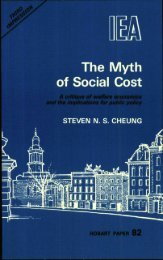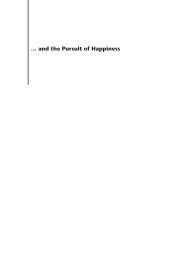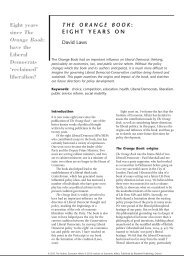Hayek's The Constitution of Liberty - Institute of Economic Affairs
Hayek's The Constitution of Liberty - Institute of Economic Affairs
Hayek's The Constitution of Liberty - Institute of Economic Affairs
You also want an ePaper? Increase the reach of your titles
YUMPU automatically turns print PDFs into web optimized ePapers that Google loves.
h ay e k ’ s t h e c o n s t i t u t i o n o f l i b e r t y<br />
t h e u s e a n d l i m i t s o f k n o w l e d g e<br />
Accounting for order is a central aim <strong>of</strong> Hayek’s political<br />
philosophy, but his discussion <strong>of</strong> it in <strong>The</strong> <strong>Constitution</strong> <strong>of</strong> <strong>Liberty</strong><br />
is quite diffuse as compared with later presentations, where he<br />
distinguishes quite clearly between the order that men deliberately<br />
make (‘organisation’) and order that forms itself (‘spontaneous<br />
order’). Both kinds <strong>of</strong> order are essential to civilisation (see<br />
1964).<br />
Hayek is widely known for his advocacy <strong>of</strong> the idea <strong>of</strong> spontaneous<br />
order. He briefly discusses the concept itself at two points<br />
in <strong>The</strong> <strong>Constitution</strong> <strong>of</strong> <strong>Liberty</strong>, although the idea <strong>of</strong> spontaneous<br />
growth is present in his discussions <strong>of</strong> tradition, liberty and<br />
progress. Hayek’s comments about organisation as a source <strong>of</strong><br />
order are scattered elsewhere in the book, so the relationship <strong>of</strong><br />
spontaneous and constructed order is not developed thematically.<br />
Hayek’s first description <strong>of</strong> spontaneous order, though not by<br />
that name, comes in Chapter 4, where he examines the contribution<br />
<strong>of</strong> eighteenth-century British thinkers to our understanding<br />
<strong>of</strong> progress. <strong>The</strong>se thinkers, especially David Hume, Adam Smith<br />
and Adam Ferguson, addressed the following question: how can<br />
social order emerge, if not from a designing human intelligence or<br />
that <strong>of</strong> a superior being? In addressing it, they<br />
showed how, in the relations among men, complex and<br />
orderly and, in a very definite sense, purposive institutions<br />
might grow up which owed little to design, which were not<br />
invented but arose from the separate actions <strong>of</strong> many men<br />
who did not know what they were doing. (58–9)<br />
<strong>The</strong> Scots in particular saw that the orderly growth <strong>of</strong> institutions<br />
takes place through ‘adaptive evolution’ or ‘the survival <strong>of</strong><br />
the successful’ (59, 57). Those tools and institutions survive which<br />
have proven themselves superior (60). This insight was central to<br />
the British case for freedom, which held that the value <strong>of</strong> freedom<br />
‘consists mainly in the opportunity it provides for the growth <strong>of</strong><br />
the undesigned’ (61).<br />
It must be emphasised that in embracing the idea <strong>of</strong> evolution,<br />
Hayek has in mind social or cultural evolution as anticipated<br />
in the teachings <strong>of</strong> eighteenth-century thinkers, particularly<br />
the Scots, and not physical evolution as taught later by Charles<br />
Darwin and others. What is crucial to cultural evolution is not the<br />
selection and transmission <strong>of</strong> physical characteristics, but rather<br />
the selection and transmission <strong>of</strong> values or rules <strong>of</strong> conduct.<br />
Cultural evolution takes place through a process <strong>of</strong> ‘winnowing<br />
and sifting,’ and where it will lead is unknowable and thus<br />
unpredictable. Certainly it does not exhibit an intelligible law.<br />
Its tendency, however, is to produce orders or structures that<br />
reflect ‘the differential advantages gained by groups from practices<br />
adopted for some unknown and perhaps purely accidental<br />
reasons’ (1979: 155; cf. 153–9, 196–200).<br />
Hayek returns to spontaneous order at the very end <strong>of</strong> Chapter<br />
10, where he draws a parallel between natural and social order.<br />
Often in the physical world we must ‘rely on the spontaneous<br />
adjustments <strong>of</strong> individual elements to produce a physical order.’<br />
For example, we ‘could never produce a crystal or a complex<br />
organic compound if we had to place each individual molecule<br />
or atom in the appropriate place in relation to the others;’ yet<br />
because the individual molecules or atoms obey a law <strong>of</strong> nature,<br />
they will in certain conditions ‘arrange themselves in a structure<br />
possessing certain characteristics’ (160). Hayek reasons that spontaneous<br />
forces can likewise produce human society when individuals<br />
act in accordance with general rules or laws. Lawmakers<br />
60<br />
61












